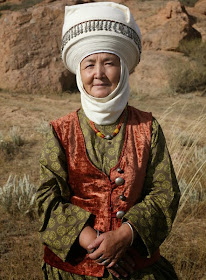 |
| Lilya Kas'yanova |
Part 1 of this article was published last week. It provided an overview of headdress customs and regional variations. This second part outlines other headdress variations and describes present-day efforts to keep this tradition alive. In particular, Lilya wishes to express her profound gratitude to Aidai Asangulova for providing much of the information for these articles.
Other headdress variations
 |
| Majestic variety of elechek worn by Elechek creative group members. Image by Erkin and Arthur Boljurovs |
In 2013, with the support of the Christensen Fund, a research project Elechek, began in Kyrgyzstan. Using material gathered during the Soviet period, the research found that age and marital status had an impact on headdress.
Young, married women wore:
jash kelinderdin kichine elechegi – a small, creative elechek and
kelin kelek – a newly married woman's turban, specific to southern Kyrgyzstan
 |
| Tunduk - Northern elechek. Image: Erkin & Arthur Boljurovs |
Middle-aged women's headdresses had no braiding. They wore either:
kaz elechek (principal elechek) – turban of vast size or
tokol elechek (moderate-size turban) – tokol means "second wife" and in the historical sources, there are references to Kyrgyz polygamy.
Elderly women wore kempir kelek, a poorly embroidered elechek.
As part of the Elechek Project, thirty women in Kyrgyzstan and the Murghab region of Tajikistan were identified as being able to wind elechek.
However, thanks largely to people such as as Nisakan Malabekova, a resident of Sary-Mogol village of Alay district in Osh Province, the great, long-standing national tradition of distinctively gorgeous head wear creations is being kept alive. Nisakan mentors her fellow villagers on how to wind kelek or sorogoy (protruding or sticking out), elechek specific for the Alay region.
Elechek project
As mentioned above, in 2013 the Elechek project was implemented with the support of the Christensen Fund, to focus on the preservation of this valuable aspect of the Kyrgyz traditional culture for present and future generations.
 |
| Alay Valley, Southern Kyrgyzstan. Image by Erkin and Arthur Boljurovs. |
Invaluable knowledge was passed from one generation to the next, i.e. the project respondents inherited the practice from their mothers, grandmothers, aunts and mothers-in-law.
As a part of the research, it was discovered that the interviewees residing in Issyk-Kul, Naryn and Osh, as well as in Murghab Region of the Tajik Republic, possess information on eight types of turban. The eight versions of elechek were then reconstructed.
On the basis of other data collected, as well as essential records and images obtained from Soviet manuscripts about the material culture of Central Asian people, five more varieties of elechek were reproduced.
The project's closing stage was marked by The Kyrgyz Traditional Elechek exhibition mounted at the Kyrgyz State Historical Museum, in Bishkek, at the end of 2013.
Director of the museum, Anarkul Isirailova, reported that the exhibition featured the reconstructed elecheks as well as headdresses in the museum's collection, obtained during the 1920s - 1950s. Historical photographs from the State cinema archives and documents from the collections of the State Historical Museum were also included.
 |
| Tunduk - Northern elechek. Image by Erkin and Arthur Boljurovs |
Contact Lilya on: lolya.87(at) mail (dot) ru
Read all Lilya's articles.
Related posts:
Elechek - Kyrgyz Traditional Headdress Part #1
100 Experiences of Kyrgyzstan
Yurts of Central Asia Part #1
Yurts of Central Asia Part #2